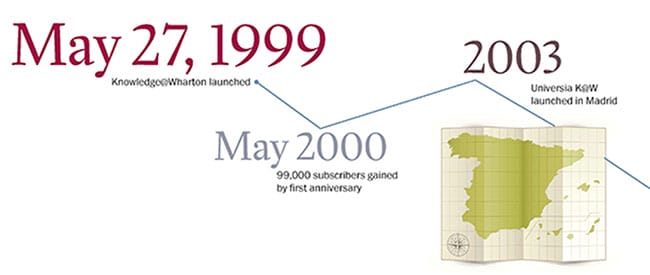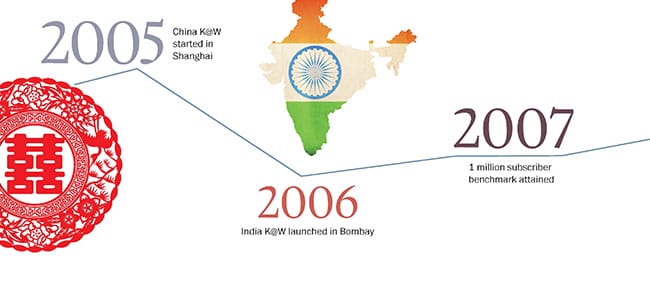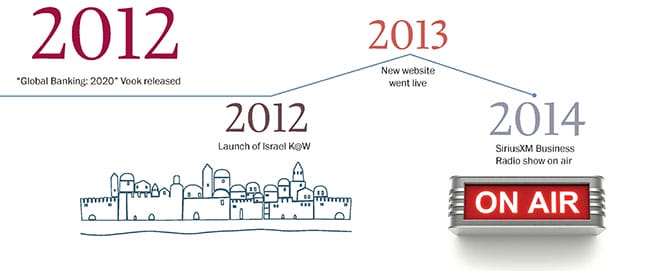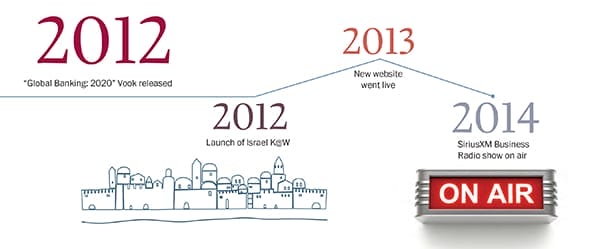In 1998, Wharton administrators charged Mukul Pandya with creating a print journal in the mold of Harvard Business Review or MIT Sloan Management Review. He urged them instead to take a chance on launching an online magazine. Produce a business plan, they responded.
Pandya recalls, “My background was journalism. … I had never written a business plan. I didn’t even know where to begin.”
He took the unusual step of registering as a client at the Wharton Small Business Development Center (SBDC), where two Wharton MBA students helped him. Part of the story, which Pandya clearly enjoys telling, is that his SBDC advisers asked him to predict the number of first-year subscribers. Looking at various Wharton newsletter circulations, he guesstimated 3,000.
In the first 48 hours of Knowledge@Wharton in May 1999, the site had something like 800 subscribers from 33 countries.
“By the end of the third week, we crossed our 3,000 goal for the year,” says Pandya, who today continues to serve as the publication’s executive director and editor-in-chief.
Now in its 15th year, K@W boasts more than 2 million subscribers (and counting) worldwide. A free resource since its inception, the digital magazine also features a searchable database of more than 6,300 articles and research abstracts on business topics from finance to marketing to technology, plus videos, podcasts, conference overviews and book reviews.
An early goal for K@W, says Pandya, was to help share Wharton’s “goldmine of intellectual capital” with the widest possible audience. While he respects the scientific rigor of academic research, he explains, a limitation is that “it’s mostly professors writing for other professors in the highly specialized language of their field.” K@W began engaging professional freelance journalists to—in Pandya’s words—“tease out the practical implications … for a busy executive who had only five minutes to spend on it.”

How Knowledge@Wharton got its start …
In addition to conveying important research accessibly, K@W has always aimed to provide “the news behind the news,” according to Robbie Shell, the recently retired senior editorial director. Shell joined the K@W staff just three months after its launch, having previously worked as editor of the Wharton Alumni Magazine (the former title of this publication).
“We might take a hard news event and try and analyze it. What does this mean for people? What does this mean for the future?” she says.
“Depth is really our calling card. While other media outlets might have the resources to continuously offer breaking news coverage, we go a step further and try to clarify all of the issues at stake,” says Steve Guglielmi, current editorial director (and another former alumni magazine editor).
To get answers, K@W frequently taps into what Pandya calls the faculty’s “tacit knowledge”—that is, their ability to authoritatively and dispassionately comment on breaking events.
“Let’s say there’s a big bank merger this morning,” he says. “A faculty member may not have sat down to write a paper about it, but they’ve been studying banking and mergers for a couple of decades. … You can ask them, ‘Will this merger create or destroy value for its shareholders?’ And they’ll tell you what they think.”
A glance at the site’s headlines gives a sense for how this approach plays out in real time—and the site’s sophisticated, up-to-the-minute, international flavor: “Vuclip’s Nickhil Jakatdar: Bringing ‘Must-have’ Mobile Video to Emerging Markets.” “Rest in Peace: Planning for Your Demise, Digitally.” “Spain Adopts the ‘Israel Model’ to Engineer a Biotech Resurgence.” “Body Slams, Vicious Dogs, Tidal Waves: How Effective Are Violent Ads?” “How the Option to Do Nothing Can Help You Get Things Done.”
A look at the K@W Media Room hints at the journal’s influence among mainstream media. The likes of The New York Times, The Economist, Entrepreneur and WealthManagement.com have recently cited its stories.

… and grew internationally.
Keeping It Free
How can all of this be achieved when the content is given away for free? While K@W receives some support from Wharton, it manages to cover a large percentage of its own costs. Custom content, or sponsored content, is a major source of revenue. Steve Sherretta, the managing editor of custom content, collaborates with prominent companies such as Boston Consulting Group, Wipro, General Electric, Ernst & Young, and Deloitte to create jointly branded material.
The projects, about 75 a year, take an array of both traditional and digital formats: white papers, special reports, surveys, and multimedia pieces such as podcasts, webcasts, webinars, videos, microsites and ebooks. Sherretta works with a company to develop a theme, then draws on subject matter experts from industry, “distilling their best thinking.” This expertise is a blend of the company’s input and the “30,000-foot view of our professors,” with K@W maintaining final editorial oversight. Sherretta says the final product is “a different kind of thought leadership” than a report produced by the company alone.
Hal Sirkin, W’80, a senior partner and managing director in Boston Consulting Group’s Chicago office, agrees: “You come up with a much better set of conclusions because you can see things from many different angles,” he says, adding that the “very mutually beneficial collaboration” with K@W allows him to tap into the network of Wharton professors.
Sirkin has worked with K@W on a number of projects about operations and globalization. One of the latest, for instance, investigates a trend called reshoring (taking manufacturing previously sent overseas and moving it back to the original country) and has so far yielded an e-book and a video. The e-book, published in 2012 and free on Amazon, is titled “The US Manufacturing Renaissance: How Shifting Global Economics Are Creating an American Comeback.” Plans are in the works for an update.
“It will probably double in size because we’ve learned so much in the interim,” he notes.
One thing, says Sirkin, that he feels sets K@W apart from other business journals is its relatively short publication cycle—“very much real time,” he says, “operating in the modern world rather than the old world” of monthly or quarterly print schedules.
K@W also has licensing arrangements with several publications. Thomas Wahl, who runs Hotel News Resource, a Toronto-based network of hotel and hospitality industry websites, has been a licensee of K@W’s content for a number of years. He describes the articles as “very topical and insightful” and notes that they consistently rank among the most read in the company’s entire network.

Knowledge@Wharton explored other languages, digital technologies and audiences …
Reaching Out
K@W continues to expand its audience globally as well. It now offers foreign-language versions in Spanish, Portuguese, Simplified Chinese and Traditional Chinese. K@W also launched a network of regional English-language editions including India Knowledge@Wharton, Arabic Knowledge@Wharton, and Israel Knowledge@Wharton, in 2006, 2010 and 2012, respectively. The English additions are now offered on one combined global site.
Manish Sabharwal, WG’96, chairman of Teamlease, India’s largest temporary services company, serves on the K@W advisory board and characterizes it as being “at the intersection of global trends and local knowledge.”
“India has a large diaspora of educated multinational managers who stay in touch with the country,” Sabharwal explains. “On the other hand, many Indian companies already operate as multinationals or have ambitions to. The Indian [section] … straddles the two perspectives.”
Another special edition created by the site is K@W High School. Its aim, according to Pandya, is to help high school students and teachers worldwide become more financially literate, as well as understand more about leadership and entrepreneurship. Launched in 2011, the site today has about 54,000 subscribers, about 400 lesson plans and a video glossary containing dozens of business terms.
Among its champions is Olivia Mitchell, Wharton’s International Foundation of Employee Benefit Plans Professor, executive director of its Pension Research Council and one of the world’s top experts on financial literacy.
“It’s really made some of the best teaching and knowledge in the field available to high school students, which is terrific,” Mitchell says.
Barbara Kahn, the Patty and Jay H. Baker Professor and director of the Jay H. Baker Retailing Center, was also involved in making K@W High School a reality and sees the effort as nothing short of extending the journal’s “global influence” and information to the next generation.
Whether their research and viewpoints appear on K@W High School or on the main site, both Mitchell and Kahn believe that the journal has helped boost their own visibility.
“It has been tremendous,” says Kahn. “I have had a lot of people reach out to me to discuss some of [my] ideas further. It has definitely increased the impact of my work.”
Mitchell recalls with a chuckle an article from a few years ago. “People that I’d known from all over the world came out of the woodwork. People I hadn’t talked to in years, maybe decades.”

… and continues to innovate today and beyond.
Revamp & Reinvigorate
A major overhaul of K@W’s website was engineered last year.
“When we started K@W, there was no Twitter, no Facebook, no LinkedIn,” says Pandya—along with no tablets, no smartphones and no cloud-based computing for fast and easy storage of streaming audio and video.
All of these considerations came into play during the facelift, yielding what is a more versatile site that makes it easier for K@W to share its stories and for readers to share their feedback. The website also incorporates multimedia and showcases the site’s considerable archive.
Rachel Kipp, a K@W associate director and a key player on the project, says that the new website facilitated the change of K@W’s publication schedule—from eight stories posted every other week to one or two new stories every day—bringing it more in line with the way today’s news sites publish.
“It makes the site feel more populated and dynamic,” she notes. “People can come to the home page every day and see something new.”
K@W had ventured into yet another medium, onethat promises possibly even greater reach for the journal and its contributors: radio. K@W now hosts a show on SiriusXM’s channel 111, Business Radio Powered by the Wharton School, which debuted on March 24 of this year. Following part of the model that made K@W successful in the first place—providing news analysis that leverages faculty expertise—Knowledge@Wharton produces 10 hours of radio content a week, or one-quarter of all programming on the Wharton channel.
Pandya is excited about the opportunity—and about the future of disseminating K@W to interested consumers, wherever they may be.
The founder says he has never forgotten the e-card he received from an anonymous reader in Africa—after he sent out a thank-you to subscribers on K@W’s anniversary. The card bore the message, “Thank you for the opportunity to learn.”
“That’s why this is more than a job for me,” he says. “Not everyone can afford to come to a place like Penn or Wharton.”
[well]By the Numbers: Knowledge@Wharton in 2014
5
Language Editions
4
Regions of Expanded Coverage
2
Hours Per Day of SiriusXM Business Radio Content
>2
Million Subscribers
[/well]

























